Photo
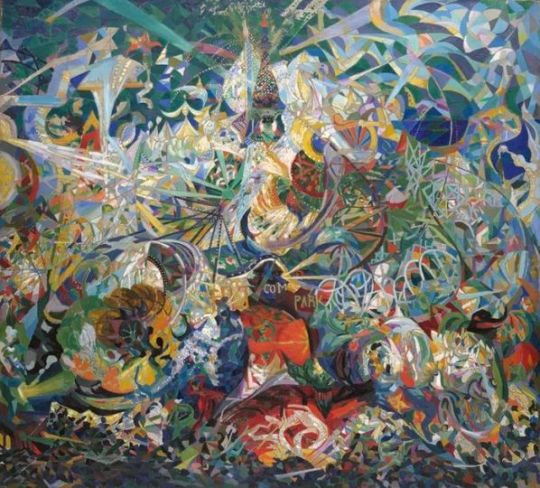
Battle of the Lights, Coney Island (1914) Joseph Stella.
Joseph Stella was an Italian-American who specialized in Futurist painting in the early 1900s. Then he transitioned to painting in the Precisionist style in the 1920s and ‘30s. Influenced by Cubism and Futurism, Precisionism emphasized America’s emergence as a modern industrialized society by highlighting its impressive bridges, skyscrapers and factories. Battle of Lights, Coney Island was one of the first successful paintings of American Futurism. Thereafter, Stella became a renowned painter in the New York art scene, though his work attracted much criticism from conservative art critics who found works of modernism threatening and impossible to define. Be that as it may, during the late 1930s and into the ‘40s, Stella’s painting style became more realistic and baroque, which didn’t fit the modernist - much less avant-garde - mold, so the art world forgot about him.
0 notes
Photo
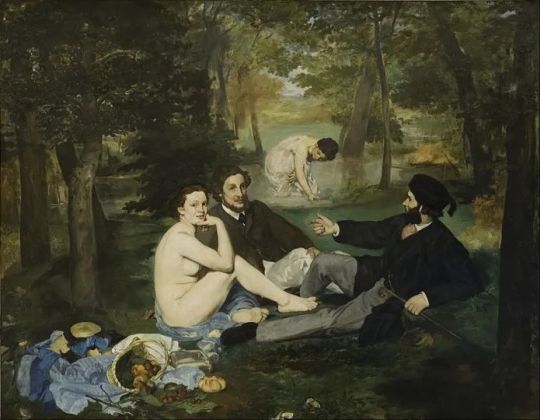
Luncheon on the Grass (1863) Édouard Manet.
Édouard Manet’s paintings are considered integral aspects of the beginning of modern art in the Western tradition. Manet, whose work bridged the gap between realism and Impressionism in the 1860s, began his artistic career by copying the work of Old Masters in the Louvre in Paris. Luncheon on the Grass, a pastoral scene using the juxtaposition of two fully dressed men and one nude woman (the woman appearing relaxed and painted in a sketchy fashion) was controversial at the time, which perhaps explains why the painting was rejected by the Paris Salon when it was first entered. Another exceedingly influential painting Manet created the same year was Olympia, which shows a reclining nude prostitute, whose defiant gaze rivets the viewer and adds greatly to the sexual tension in the piece. Curiously, this painting was accepted by the Paris Salon!.
0 notes
Photo
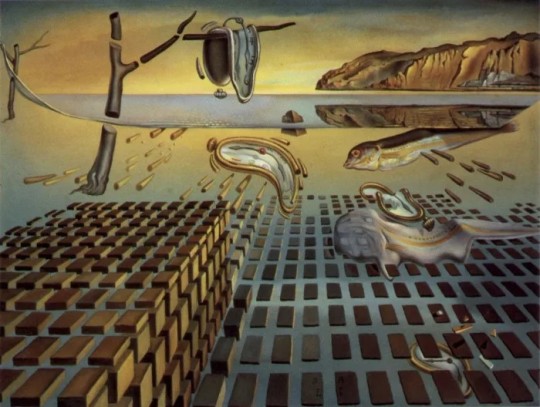
Disintegration of the Persistence of Memory (1954) Salvador Dalí
Certainly one of the most eccentric, narcissistic artists of all time, Salvador Dalí once said, “I am not strange. I’m just not normal.” His grandiose demeanor aside, Dalí’s genius as a great painter is without peer, particularly as it relates to the masters of Surrealism. Astonishing and bizarre, Dalí’s images cannot be forgotten. It’s hard to believe they could have sprung from the mind of a human being! In The Disintegration of the Persistence of Memory, Dalí, using his interpretation of quantum mechanics, deconstructs perhaps his most famous work, The Persistence of Memory (1931). Whether one painting is better than the other, who can say? Interestingly, in 2017, Dalí’s corpse was disinterred for DNA evidence to settle a paternity suit. It turned out the kid wasn’t his! Also, shortly before his death in 1989, he said, “When you are a genius, you do not have the right to die, because we are necessary for the progress of humanity.”.
0 notes
Photo

The Love Embrace of the Universe (1949) Frida Kahlo
Despite having polio and being seriously injured in a traffic accident at 18, for which she suffered medical problems the rest of her life, Frida Kahlo had an impressive career as a Mexican Surrealist painter (or Magical Realist, painters using realism with fantasy elements added). While living, Kahlo wasn’t well known as an artist, simply muralist Diego Rivera’s wife, until the 1970s, that is, when her legacy attacked the attention of Chicanos, feminists, the LGBTQ movement and Native Americans. Now people wrote books about her! Kahlo’s painting, The Love Embrace of the Universe, shows Kahlo with Diego Rivera, as they’re embraced by Mexico, the Earth and the Universe. Often mythologized, for better or worse, Kahlo has become one of the most recognized artists of the twentieth century. Interestingly, in 2018, the San Francisco Board of Supervisors changed the name of Phelan Avenue to Frida Kahlo Way.
.
0 notes
Photo
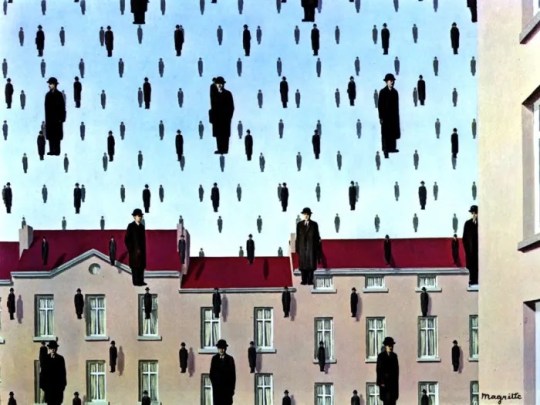
Golconda (1953) René Magritte
.
A Belgian Surrealist, René Magritte liked painting artworks that challenged people’s sense of reality. Often depicting ordinary objects and/or people in unusual, improbable or fantastic settings, Magritte’s paintings take you on a dreamy trip to your own subconscious– or perhaps the collective subconscious of humankind, if such a thing exists. Golconda shows a residential scene of red-roofed buildings, over which numerous middle-aged men dressed in overcoats and bowler hats (as Magritte often depicted himself in paintings) are seen falling from the sky – or suspended in air in a kind of grid pattern. Are these men individuals or multiples of the same man? Curiously, Magritte’s mother committed suicide when he was 14, and it’s been theorized that his puzzling artworks shift from a state of her being alive – or dead.
0 notes
Photo
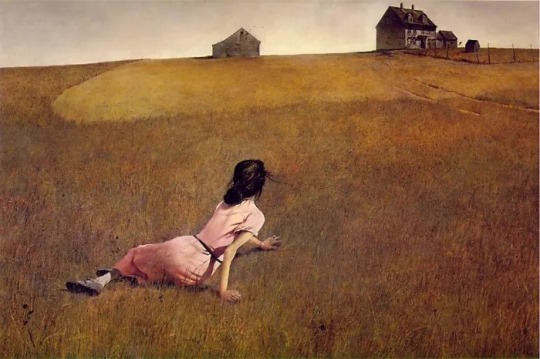
Christina’s World (1948) Andrew Wyeth
.
Christina’s World is one of the most recognizable American paintings of the twentieth century. It depicts a woman crawling across a treeless field as she gazes at a house and other smaller buildings in the distance. The woman is Anna Christina Olson, who suffered from Charcot-Marie-Tooth disease, an incurable illness causing the progressive loss of muscle tissue. Regarding the painting’s inclusion is pop culture, it has appeared movies such as: 2001: A Space Odyssey (the painting hangs on the wall of a hotel room through which walks astronaut David Bowman after he passes through the star gate) and War on Everyone, in which a character looks at a print of the painting and says, “It’s kinda creepy. It's like something bad's gonna happen but there's nothing she can do about it.”
0 notes
Photo
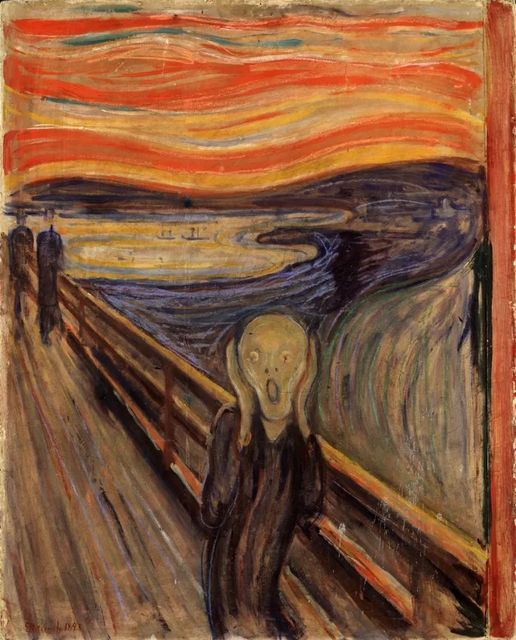
The Scream (1893) Edvard Munch
.
Norwegian artist Edvard Munch, a man beset by psychological problems (severe mental illness ran in his family), created one of the most famous paintings of modern times. The Scream symbolizes to many the anxiety of modern humankind, though Munch himself said he painted it as a reaction to seeing a blood-red sunset, which seemed to him a “scream of nature.” Over the decades when his paintings became exemplars of German Expressionism, Munch strove to create paintings that showed his current psychological state, even though this state may have included suicidal thoughts, pessimism, alcoholism or violent behavior. One critic wrote: "With ruthless contempt for form, clarity, elegance, wholeness, and realism, he paints with intuitive strength of talent the most subtle visions of the soul."
0 notes
Photo

Hay Harvest at Éragny (1901) Camille Pissarro
.
Camille Pissarro was a pioneer of French Impressionism and neo-Impressionism; in fact, he was the only painter to show his work at all Paris Impressionism exhibitions from 1874 to 1886. Moreover, he was a father figure to such great Impressionists as Georges Seurat, Paul Cézanne, Vincent van Gogh and Paul Gauguin. Art historian John Reward called him the “dean of Impressionist painters,” because he was the oldest in the group and had a pleasant, affable personality. Hay Harvest at Éragny shows Pissarro’s penchant for painting country folk performing simple tasks. In 1882, Pierre-Auguste Renior said Pissarro’s work at this time was “revolutionary.” Hay Harvest highlights Pissarro’s interest in Neo-Impressionism, particularly his use of pointillism; actually, he was the only Impressionist painter to eventually switch to neo-Impressionism.
0 notes
Photo
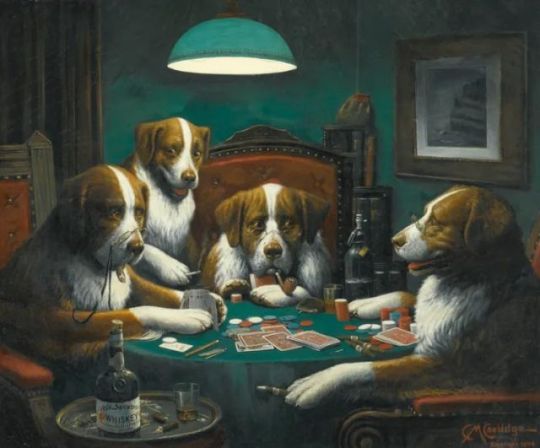
Poker Game (1894) Cassius Marcellus Coolidge
.
Cassius Coolidge was born in Antwerp, New York. His parents were abolitionist Quakers. Coolidge, having no fondness for farm labor, left the fields in the 1860s and began earning a living by painting signs, illustrating books and creating cartoons for a newspaper. Even though Coolidge had little training as an artist, he was well-educated. Then, while working in carnivals, he created life-size, novelty portraits with comedic elements, what became known as comic foregrounds. Poker Game is one of 16 in a series of calendar paintings Coolidge produced in the early 1900s. All of these artworks show anthropomorphic dogs engaged in human activities such as playing poker. Coolidge is credited with creating this motif, which he also used to paint dogs playing pool. Notably, Poker Game sold for $658,000 in 2015.
0 notes
Photo

Nude Sitting on a Divan (1917) Amedeo Modigliani
.
Italian painter and sculptor, Amedeo Modigliani, though not famous during his short lifetime (35 at death in 1920), nevertheless his stylized portraits and nudes eventually became popular posthumously. Mainly working in Paris, France in the early 1900s, Modigliani’s figures often show men and women with elongated heads and necks and, at times, full-figured bodies, which drew jeers from critics and aficionados. In 1917, Modigliani had the only solo exhibition in his life, for which he showed many female nudes, including Nude Sitting on a Divan, which caused a sensation. Also exhibited at the same show, Nu couché au coussin Bleu (1916), a reclining nude, sold for $170 million in 2015.
0 notes
Photo

Untitled (Skull) (1981) Jean-Michel
Basquiat.An artist of Neo-expressionism in the late modernist, early postmodern period, Jean-Michel Basquiat was an African-American artist who lived and painted in the Lower East Side of Manhattan during the 1980s when his artworks were being exhibited locally and internationally. Basquiat’s paintings had a graffiti-like, urban look and used social commentary to evoke introspection and were often charged with political criticism or class struggle issues, racism and colonialism. His artwork has inspired many hip-hop artists such as Jay-Z. The Skull painting reflected Basquiat’s seminal interest in heads and skulls, which he often drew or painted. Notably, in the middle 1980s, Basquiat developed a friendship and artistic corroboration with Andy Warhol and, coincidentally, both died about the same time - Warhol (1987) and Basquiat (1988).
0 notes
Photo
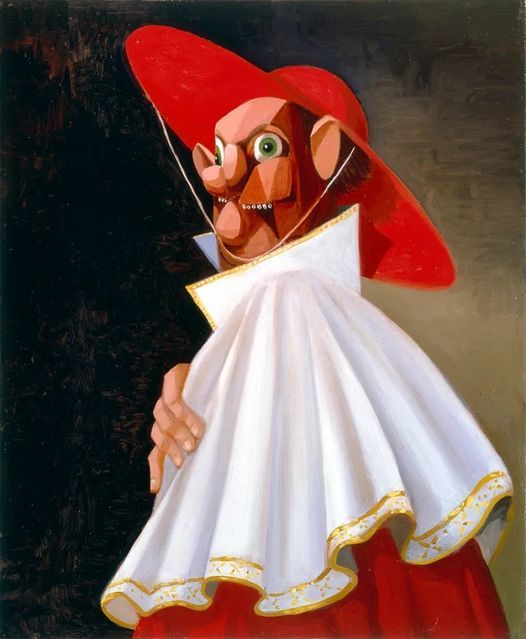
The Cracked Cardinal (2001) George Condo.
One of many contemporary artists living and working in NYC, George Condo established his artistry in the East Village, creating what he called Artificial Realism, a combination of European Old Master painting and Pop Art. One of many artists who comprised a revival of painting in America, Condo exhibited his artworks in the 1980s, and he also worked at Andy Warhol’s factory, though primarily producing silkscreen prints at that venue. Condo has also corroborated with author William S. Burroughs. Eventually developing a style of painting that combines pop culture figures with humor and grotesque imagery, what Condo calls Psychological Cubism, he produced The Cracked Cardinal and many other similar paintings of this style in the early 2000s. To conclude, if there’s a more popular and influential artist in contemporary America, who would that be?
0 notes
Photo

Henri Rousseau, The Sleeping Gypsy (1897)
The subject matter of this oil painting was unlike anything the artist had done before - leading some to claim it was a forgery. Rousseau, who was largely self-taught, was a student of primitivism, which focuses on non-Western themes. The desert scene depicts a sleeping woman dressed in Eastern costume with a wandering lion behind her. The moonlight in the background gives the piece a dreamlike quality.
0 notes
Photo

James Nachtwey | Famine in Somalia | 1992
.
“Dare we say that it doesn’t get any worse than this?”
New York Times Magazine reader upon seeing Nachtwey’s image
Unable to get an assignment to document the 1992 famine in Somalia photojournalist James Nachtwey decided to go alone.
Supported on the ground by the Red Cross, Nachtwey captured the horrors of the famine. This, his most haunting image captures a woman in a wheelbarrow waiting to be taken to a feeding center.
After the publication of his harrowing images the Red Cross received the biggest wave of public support since WWII and were able to save ONE and a half million people.
.
( I have been a witness, and these pictures are my testimony. The events I have recorded should not be forgotten and must not be repeated. -James Nachtwey )
0 notes
Photo
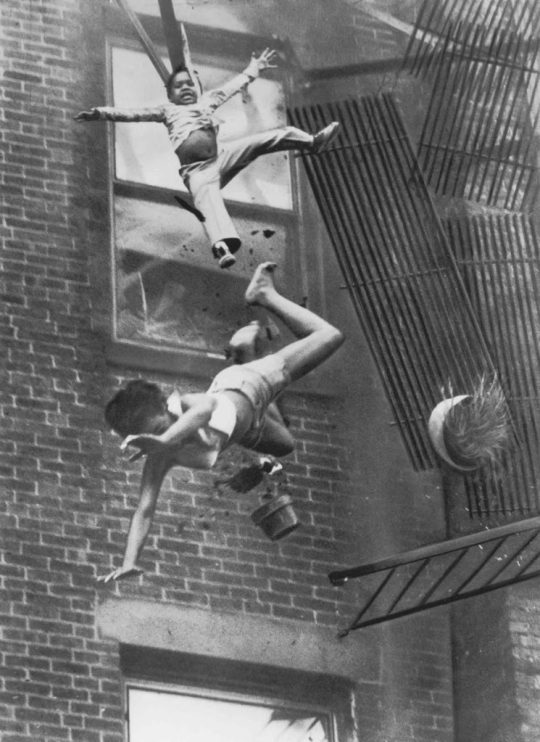
Stanley Forman’s famous photo Woman Falling From Fire Escape |1975
.Forman was a well-known photographer working for the Boston Herald when he attended the scene of a fire. What began as him documenting the rescue of a young woman and child quickly took a turn when the fire escape collapsed.The pair began to fall and he continued shooting as they were falling. He capturing them swimming through the air. Forman only lowered his camera and turned at the last moment when he realized what he was witnessing was a woman plummeting to her death.This famous photograph won Forman a Pulitzer prize. But its interesting legacy is the ethical questions it raised about when a photographer should stop shooting and whether it is appropriate to publish disturbing images. It also caused many municipalities to enforce stricter fire-escape safety codes, so you decide.
0 notes
Photo

Traveling through New Orleans on a cross-country road trip in 1955, the Swiss-born photographer Robert Frank snapped a picture of a passing streetcar. The result, Trolley—New Orleans, is a searing image of everyday racism.
The streetcar’s riders, framed by the vehicle’s windows, are divided by race: white passengers sit in front, Black passengers in back, as mandated by Louisiana law under Jim Crow.
When Trolley—New Orleans appeared on the cover of Frank’s landmark photobook 'The Americans' in 1959, New Orleans’s streetcars had been desegregated for more than a year, but the civil rights struggles of the 1960s still lay ahead.
—
Robert Frank. Trolley—New Orleans. 1955. Gelatin silver print. © Andrea Frank Foundation, from The Americans
https://www.facebook.com/thegalleryofmodernart/photos/a.151452706407202/288267266059078/
1 note
·
View note